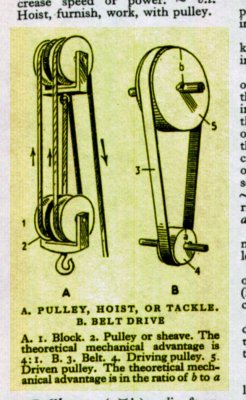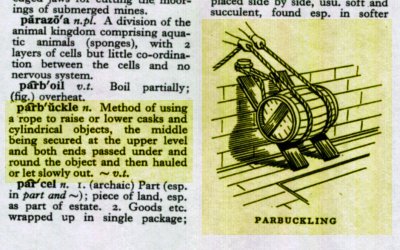
| MadSci Network: Science History |
Hello John.
That's a great question which provides the foundation for some wonderful engineering history. I'm afraid that I have some bad news for you as well as some good news. The bad news is that I cannot attribute the invention of the pulley to a single individual, but the good news is that I can give you a trip back in time and see how, when, and by who the pulley was used and developed.
Let's start by stating that thinking man has been around for the last 35,000 years (which is scary in itself - that means that it's only been 500 human lifetimes between caves and Pentium chips). Evidence of cultivation and farming appears at 8000 BC, metallurgy at 6000 BC, and textiles at 4000 BC. If we assume that it takes some reasonable level of thought and communication to establish a civilisation, then we can guess that the first communal settlements developed into some semblance of cities around the same time as the birth of recorded thought. Sumer in Mesopotamia saw the dawn of writing at about 3500 BC and is also the earliest known organised civilisation. Shortly afterwards came Egypt, the far East, and southern Europe. For these civilisations to be built it is inevitable that basic engineering mechanisms such as ropes, wheels, and levers were employed even though their mathematics was not understood. We can therefore place the birth of the pulley wheel around 5000 BC give or take a few thousand years.
Let's jump forward to Greece in about 500 BC, and look at the dawn of science. Thinkers such as Socrates, Plato, and Pythagoras developed 'philosophy' as being sequences of thought by which we can rationalise what happens around us. Experimentation was frowned upon in favour of theory, and most mechanical mathematics appeared. In 400 BC Archytus the Tarantinean developed the mechanical mathematics of the pulley and realised that, when used in formation, it seemed to produce power beyond effort. If a pulley block had four ropes, then the operator needed only one quarter of the force to lift the required load - man had strength beyond himself. This strength is a term which we apply to all simple machines and is called 'Mechanical Advantage'. Here is a picture from the splendid 'Reader's Digest Encyclopaedic Dictionary'..

With this theory explained and recorded, the pulley system that had hitherto been used but not understood, started to appear everywhere. In 200 BC, Archimedes, one of the fathers of engineering, used pulleys and levers to defend Greece from the Romans in ways that struck fear into the attacking soldiers. The walls of Syracuse were defended by huge arms that could reach into the sea and overturn whole ships. Huge machines of war could now be operated with much less effort, and so they grew.
As we look around us we see that the most simple engineering tools have followed us, are all around us, and have shaped our world. Here is a picture of the practice used to load barrels and cargo onto ships. Can you see the similarity with the pulley system? In this picture, each hand is pulling with only one quarter of the force that the barrel exerts back down the slope.

We owe it all to the forefathers of engineering thought. The mechanical revolution gave way to the industrial revolution without which we could not have sustained the silicon revolution which in turn supports the information age. Finally, I am able to use the Internet to tell you how it all came about. Engineering is defined as being 'that branch of science which concerns itself with harnessing the powers of nature for the furtherance of man.'
Carry the torch on, John. Build something wonderful.
Discover.
Justin Roux.
Try the links in the MadSci Library for more information on Science History.